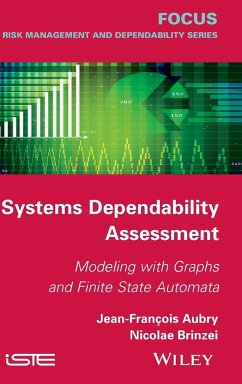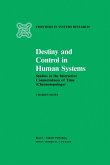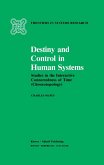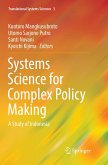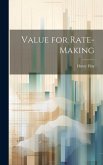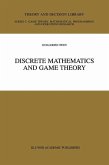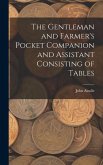Jean-Francois Aubry, Nicolae Brinzei
Systems Dependability Assessment
Modeling with Graphs and Finite State Automata
Jean-Francois Aubry, Nicolae Brinzei
Systems Dependability Assessment
Modeling with Graphs and Finite State Automata
- Gebundenes Buch
- Merkliste
- Auf die Merkliste
- Bewerten Bewerten
- Teilen
- Produkt teilen
- Produkterinnerung
- Produkterinnerung
Presents recent developments of probabilistic assessment of systems dependability based on stochastic models, including graph theory, finite state automaton and language theory, for both dynamic and hybrid contexts.
Andere Kunden interessierten sich auch für
![Destiny and Control in Human Systems Destiny and Control in Human Systems]() C. MusésDestiny and Control in Human Systems125,99 €
C. MusésDestiny and Control in Human Systems125,99 €![Destiny and Control in Human Systems Destiny and Control in Human Systems]() C. MusésDestiny and Control in Human Systems192,99 €
C. MusésDestiny and Control in Human Systems192,99 €![Systems Science for Complex Policy Making Systems Science for Complex Policy Making]() Systems Science for Complex Policy Making41,99 €
Systems Science for Complex Policy Making41,99 €![Value for Rate-Making Value for Rate-Making]() Henry FloyValue for Rate-Making39,99 €
Henry FloyValue for Rate-Making39,99 €![Discrete Mathematics and Game Theory Discrete Mathematics and Game Theory]() Guillermo OwenDiscrete Mathematics and Game Theory161,99 €
Guillermo OwenDiscrete Mathematics and Game Theory161,99 €![The Gentleman and Farmer's Pocket Companion and Assistant Consisting of Tables The Gentleman and Farmer's Pocket Companion and Assistant Consisting of Tables]() John AinslieThe Gentleman and Farmer's Pocket Companion and Assistant Consisting of Tables37,99 €
John AinslieThe Gentleman and Farmer's Pocket Companion and Assistant Consisting of Tables37,99 €![Capital Account Liberation Capital Account Liberation]() Ying YirongCapital Account Liberation190,99 €
Ying YirongCapital Account Liberation190,99 €-
-
-
Presents recent developments of probabilistic assessment of systems dependability based on stochastic models, including graph theory, finite state automaton and language theory, for both dynamic and hybrid contexts.
Hinweis: Dieser Artikel kann nur an eine deutsche Lieferadresse ausgeliefert werden.
Hinweis: Dieser Artikel kann nur an eine deutsche Lieferadresse ausgeliefert werden.
Produktdetails
- Produktdetails
- Verlag: Wiley
- Seitenzahl: 198
- Erscheinungstermin: 16. Februar 2015
- Englisch
- Abmessung: 240mm x 161mm x 15mm
- Gewicht: 469g
- ISBN-13: 9781848217652
- ISBN-10: 184821765X
- Artikelnr.: 42056127
- Herstellerkennzeichnung
- Libri GmbH
- Europaallee 1
- 36244 Bad Hersfeld
- gpsr@libri.de
- Verlag: Wiley
- Seitenzahl: 198
- Erscheinungstermin: 16. Februar 2015
- Englisch
- Abmessung: 240mm x 161mm x 15mm
- Gewicht: 469g
- ISBN-13: 9781848217652
- ISBN-10: 184821765X
- Artikelnr.: 42056127
- Herstellerkennzeichnung
- Libri GmbH
- Europaallee 1
- 36244 Bad Hersfeld
- gpsr@libri.de
Pr. Jean-François AUBRY Professor Emeritus, University of Lorraine, France. Dr. Nicolae BRINZEI, Associate Professor, University of Lorraine, France.
PREFACE ix
INTRODUCTION xiii
PART 1. PREDICTED RELIABILITY OF STATIC SYSTEMS; A GRAPH-THEORY BASED
APPROACH 1
CHAPTER 1. STATIC AND TIME INVARIANT SYSTEMS WITH BOOLEAN REPRESENTATION 3
1.1. Notations 3
1.2. Order relation on U 4
1.3. Structure of a system 6
1.3.1. State diagram of a system 6
1.3.2. Monotony of an SF, coherence of a system 7
1.4. Cut-set and tie-set of a system 9
1.4.1. Tie-set 9
1.4.2. Cut-set 10
CHAPTER 2. RELIABILITY OF A COHERENT SYSTEM 13
2.1. Demonstrating example 15
2.2. The reliability block diagram (RBD) 18
2.3. The fault tree (FT) 21
2.4. The event tree 26
2.5. The structure function as a minimal union of disjoint monomials 28
2.5.1. Ordered graph of a monotone structure function 29
2.5.2. Maxima and minima of the ordered graph 31
2.5.3. Ordered subgraphs of the structure function 32
2.5.4. Introductory example 33
2.5.5. Construction of the minimal Boolean form 37
2.5.6. Complexity 43
2.5.7. Comparison with the BDD approach 45
2.6. Obtaining the reliability equation from the Boolean equation 49
2.6.1. The traditional approach 49
2.6.2. Comparison with the structure function by Kaufmann 50
2.7. Obtain directly the reliability from the ordered graph 52
2.7.1. Ordered weighted graph 53
2.7.2. Algorithm 56
2.7.3. Performances of the algorithm 59
CHAPTER 3. WHAT ABOUT NON-COHERENT SYSTEMS? 61
3.1. Example of a non-coherent supposed system 61
3.2. How to characterize the non-coherence of a system? 63
3.3. Extension of the ordered graph method 66
3.3.1. Decomposition algorithm 67
3.4. Generalization of the weighted graph algorithm 68
CONCLUSION TO PART 1 73
PART 2. PREDICTED DEPENDABILITY OF SYSTEMS IN A DYNAMIC CONTEXT 75
INTRODUCTION TO PART 2 77
CHAPTER 4. FINITE STATE AUTOMATON 83
4.1. The context of discrete event system 83
4.2. The basic model 84
CHAPTER 5. STOCHASTIC FSA 89
5.1. Basic definition 89
5.2. Particular case: Markov and semi-Markov processes 90
5.3. Interest of the FSA model 91
5.4. Example of stochastic FSA 92
5.5. Probability of a sequence 93
5.6. Simulation with Scilab 94
5.7. State/event duality 95
5.8. Construction of a stochastic SFA 96
CHAPTER 6. GENERALIZED STOCHASTIC FSA 101
CHAPTER 7. STOCHASTIC HYBRID AUTOMATON 105
7.1. Motivation 105
7.2. Formal definition of the model 105
7.3. Implementation 107
7.4. Example 109
7.5. Other examples 116
7.5.1. Control temperature of an oven 116
7.5.2. Steam generator of a nuclear power plant 118
7.6. Conclusion 120
CHAPTER 8. OTHER MODELS/TOOLS FOR DYNAMIC DEPENDABILITY VERSUS SHA 121
8.1. The dynamic fault trees 121
8.1.1. Principle 121
8.1.2. Equivalence with the FSA approach 124
8.1.3. Covered criteria 126
8.2. The Boolean logic-driven Markov processes 126
8.2.1. Principle 126
8.2.2. Equivalence with the FSA approach 127
8.2.3. Covered criteria 127
8.3. The dynamic event trees (DETs) 128
8.3.1. Principle 128
8.3.2. Equivalence with the FSA approach 129
8.3.3. Covered criteria 130
8.4. The piecewise deterministic Markov processes 131
8.4.1. Principle 131
8.4.2. Equivalence with the FSA approach 131
8.4.3. Covered criteria 132
8.5. Other approaches 132
CONCLUSION AND PERSPECTIVES 135
APPENDIX 137
BIBLIOGRAPHY 173
INDEX 181
INTRODUCTION xiii
PART 1. PREDICTED RELIABILITY OF STATIC SYSTEMS; A GRAPH-THEORY BASED
APPROACH 1
CHAPTER 1. STATIC AND TIME INVARIANT SYSTEMS WITH BOOLEAN REPRESENTATION 3
1.1. Notations 3
1.2. Order relation on U 4
1.3. Structure of a system 6
1.3.1. State diagram of a system 6
1.3.2. Monotony of an SF, coherence of a system 7
1.4. Cut-set and tie-set of a system 9
1.4.1. Tie-set 9
1.4.2. Cut-set 10
CHAPTER 2. RELIABILITY OF A COHERENT SYSTEM 13
2.1. Demonstrating example 15
2.2. The reliability block diagram (RBD) 18
2.3. The fault tree (FT) 21
2.4. The event tree 26
2.5. The structure function as a minimal union of disjoint monomials 28
2.5.1. Ordered graph of a monotone structure function 29
2.5.2. Maxima and minima of the ordered graph 31
2.5.3. Ordered subgraphs of the structure function 32
2.5.4. Introductory example 33
2.5.5. Construction of the minimal Boolean form 37
2.5.6. Complexity 43
2.5.7. Comparison with the BDD approach 45
2.6. Obtaining the reliability equation from the Boolean equation 49
2.6.1. The traditional approach 49
2.6.2. Comparison with the structure function by Kaufmann 50
2.7. Obtain directly the reliability from the ordered graph 52
2.7.1. Ordered weighted graph 53
2.7.2. Algorithm 56
2.7.3. Performances of the algorithm 59
CHAPTER 3. WHAT ABOUT NON-COHERENT SYSTEMS? 61
3.1. Example of a non-coherent supposed system 61
3.2. How to characterize the non-coherence of a system? 63
3.3. Extension of the ordered graph method 66
3.3.1. Decomposition algorithm 67
3.4. Generalization of the weighted graph algorithm 68
CONCLUSION TO PART 1 73
PART 2. PREDICTED DEPENDABILITY OF SYSTEMS IN A DYNAMIC CONTEXT 75
INTRODUCTION TO PART 2 77
CHAPTER 4. FINITE STATE AUTOMATON 83
4.1. The context of discrete event system 83
4.2. The basic model 84
CHAPTER 5. STOCHASTIC FSA 89
5.1. Basic definition 89
5.2. Particular case: Markov and semi-Markov processes 90
5.3. Interest of the FSA model 91
5.4. Example of stochastic FSA 92
5.5. Probability of a sequence 93
5.6. Simulation with Scilab 94
5.7. State/event duality 95
5.8. Construction of a stochastic SFA 96
CHAPTER 6. GENERALIZED STOCHASTIC FSA 101
CHAPTER 7. STOCHASTIC HYBRID AUTOMATON 105
7.1. Motivation 105
7.2. Formal definition of the model 105
7.3. Implementation 107
7.4. Example 109
7.5. Other examples 116
7.5.1. Control temperature of an oven 116
7.5.2. Steam generator of a nuclear power plant 118
7.6. Conclusion 120
CHAPTER 8. OTHER MODELS/TOOLS FOR DYNAMIC DEPENDABILITY VERSUS SHA 121
8.1. The dynamic fault trees 121
8.1.1. Principle 121
8.1.2. Equivalence with the FSA approach 124
8.1.3. Covered criteria 126
8.2. The Boolean logic-driven Markov processes 126
8.2.1. Principle 126
8.2.2. Equivalence with the FSA approach 127
8.2.3. Covered criteria 127
8.3. The dynamic event trees (DETs) 128
8.3.1. Principle 128
8.3.2. Equivalence with the FSA approach 129
8.3.3. Covered criteria 130
8.4. The piecewise deterministic Markov processes 131
8.4.1. Principle 131
8.4.2. Equivalence with the FSA approach 131
8.4.3. Covered criteria 132
8.5. Other approaches 132
CONCLUSION AND PERSPECTIVES 135
APPENDIX 137
BIBLIOGRAPHY 173
INDEX 181
PREFACE ix
INTRODUCTION xiii
PART 1. PREDICTED RELIABILITY OF STATIC SYSTEMS; A GRAPH-THEORY BASED
APPROACH 1
CHAPTER 1. STATIC AND TIME INVARIANT SYSTEMS WITH BOOLEAN REPRESENTATION 3
1.1. Notations 3
1.2. Order relation on U 4
1.3. Structure of a system 6
1.3.1. State diagram of a system 6
1.3.2. Monotony of an SF, coherence of a system 7
1.4. Cut-set and tie-set of a system 9
1.4.1. Tie-set 9
1.4.2. Cut-set 10
CHAPTER 2. RELIABILITY OF A COHERENT SYSTEM 13
2.1. Demonstrating example 15
2.2. The reliability block diagram (RBD) 18
2.3. The fault tree (FT) 21
2.4. The event tree 26
2.5. The structure function as a minimal union of disjoint monomials 28
2.5.1. Ordered graph of a monotone structure function 29
2.5.2. Maxima and minima of the ordered graph 31
2.5.3. Ordered subgraphs of the structure function 32
2.5.4. Introductory example 33
2.5.5. Construction of the minimal Boolean form 37
2.5.6. Complexity 43
2.5.7. Comparison with the BDD approach 45
2.6. Obtaining the reliability equation from the Boolean equation 49
2.6.1. The traditional approach 49
2.6.2. Comparison with the structure function by Kaufmann 50
2.7. Obtain directly the reliability from the ordered graph 52
2.7.1. Ordered weighted graph 53
2.7.2. Algorithm 56
2.7.3. Performances of the algorithm 59
CHAPTER 3. WHAT ABOUT NON-COHERENT SYSTEMS? 61
3.1. Example of a non-coherent supposed system 61
3.2. How to characterize the non-coherence of a system? 63
3.3. Extension of the ordered graph method 66
3.3.1. Decomposition algorithm 67
3.4. Generalization of the weighted graph algorithm 68
CONCLUSION TO PART 1 73
PART 2. PREDICTED DEPENDABILITY OF SYSTEMS IN A DYNAMIC CONTEXT 75
INTRODUCTION TO PART 2 77
CHAPTER 4. FINITE STATE AUTOMATON 83
4.1. The context of discrete event system 83
4.2. The basic model 84
CHAPTER 5. STOCHASTIC FSA 89
5.1. Basic definition 89
5.2. Particular case: Markov and semi-Markov processes 90
5.3. Interest of the FSA model 91
5.4. Example of stochastic FSA 92
5.5. Probability of a sequence 93
5.6. Simulation with Scilab 94
5.7. State/event duality 95
5.8. Construction of a stochastic SFA 96
CHAPTER 6. GENERALIZED STOCHASTIC FSA 101
CHAPTER 7. STOCHASTIC HYBRID AUTOMATON 105
7.1. Motivation 105
7.2. Formal definition of the model 105
7.3. Implementation 107
7.4. Example 109
7.5. Other examples 116
7.5.1. Control temperature of an oven 116
7.5.2. Steam generator of a nuclear power plant 118
7.6. Conclusion 120
CHAPTER 8. OTHER MODELS/TOOLS FOR DYNAMIC DEPENDABILITY VERSUS SHA 121
8.1. The dynamic fault trees 121
8.1.1. Principle 121
8.1.2. Equivalence with the FSA approach 124
8.1.3. Covered criteria 126
8.2. The Boolean logic-driven Markov processes 126
8.2.1. Principle 126
8.2.2. Equivalence with the FSA approach 127
8.2.3. Covered criteria 127
8.3. The dynamic event trees (DETs) 128
8.3.1. Principle 128
8.3.2. Equivalence with the FSA approach 129
8.3.3. Covered criteria 130
8.4. The piecewise deterministic Markov processes 131
8.4.1. Principle 131
8.4.2. Equivalence with the FSA approach 131
8.4.3. Covered criteria 132
8.5. Other approaches 132
CONCLUSION AND PERSPECTIVES 135
APPENDIX 137
BIBLIOGRAPHY 173
INDEX 181
INTRODUCTION xiii
PART 1. PREDICTED RELIABILITY OF STATIC SYSTEMS; A GRAPH-THEORY BASED
APPROACH 1
CHAPTER 1. STATIC AND TIME INVARIANT SYSTEMS WITH BOOLEAN REPRESENTATION 3
1.1. Notations 3
1.2. Order relation on U 4
1.3. Structure of a system 6
1.3.1. State diagram of a system 6
1.3.2. Monotony of an SF, coherence of a system 7
1.4. Cut-set and tie-set of a system 9
1.4.1. Tie-set 9
1.4.2. Cut-set 10
CHAPTER 2. RELIABILITY OF A COHERENT SYSTEM 13
2.1. Demonstrating example 15
2.2. The reliability block diagram (RBD) 18
2.3. The fault tree (FT) 21
2.4. The event tree 26
2.5. The structure function as a minimal union of disjoint monomials 28
2.5.1. Ordered graph of a monotone structure function 29
2.5.2. Maxima and minima of the ordered graph 31
2.5.3. Ordered subgraphs of the structure function 32
2.5.4. Introductory example 33
2.5.5. Construction of the minimal Boolean form 37
2.5.6. Complexity 43
2.5.7. Comparison with the BDD approach 45
2.6. Obtaining the reliability equation from the Boolean equation 49
2.6.1. The traditional approach 49
2.6.2. Comparison with the structure function by Kaufmann 50
2.7. Obtain directly the reliability from the ordered graph 52
2.7.1. Ordered weighted graph 53
2.7.2. Algorithm 56
2.7.3. Performances of the algorithm 59
CHAPTER 3. WHAT ABOUT NON-COHERENT SYSTEMS? 61
3.1. Example of a non-coherent supposed system 61
3.2. How to characterize the non-coherence of a system? 63
3.3. Extension of the ordered graph method 66
3.3.1. Decomposition algorithm 67
3.4. Generalization of the weighted graph algorithm 68
CONCLUSION TO PART 1 73
PART 2. PREDICTED DEPENDABILITY OF SYSTEMS IN A DYNAMIC CONTEXT 75
INTRODUCTION TO PART 2 77
CHAPTER 4. FINITE STATE AUTOMATON 83
4.1. The context of discrete event system 83
4.2. The basic model 84
CHAPTER 5. STOCHASTIC FSA 89
5.1. Basic definition 89
5.2. Particular case: Markov and semi-Markov processes 90
5.3. Interest of the FSA model 91
5.4. Example of stochastic FSA 92
5.5. Probability of a sequence 93
5.6. Simulation with Scilab 94
5.7. State/event duality 95
5.8. Construction of a stochastic SFA 96
CHAPTER 6. GENERALIZED STOCHASTIC FSA 101
CHAPTER 7. STOCHASTIC HYBRID AUTOMATON 105
7.1. Motivation 105
7.2. Formal definition of the model 105
7.3. Implementation 107
7.4. Example 109
7.5. Other examples 116
7.5.1. Control temperature of an oven 116
7.5.2. Steam generator of a nuclear power plant 118
7.6. Conclusion 120
CHAPTER 8. OTHER MODELS/TOOLS FOR DYNAMIC DEPENDABILITY VERSUS SHA 121
8.1. The dynamic fault trees 121
8.1.1. Principle 121
8.1.2. Equivalence with the FSA approach 124
8.1.3. Covered criteria 126
8.2. The Boolean logic-driven Markov processes 126
8.2.1. Principle 126
8.2.2. Equivalence with the FSA approach 127
8.2.3. Covered criteria 127
8.3. The dynamic event trees (DETs) 128
8.3.1. Principle 128
8.3.2. Equivalence with the FSA approach 129
8.3.3. Covered criteria 130
8.4. The piecewise deterministic Markov processes 131
8.4.1. Principle 131
8.4.2. Equivalence with the FSA approach 131
8.4.3. Covered criteria 132
8.5. Other approaches 132
CONCLUSION AND PERSPECTIVES 135
APPENDIX 137
BIBLIOGRAPHY 173
INDEX 181

